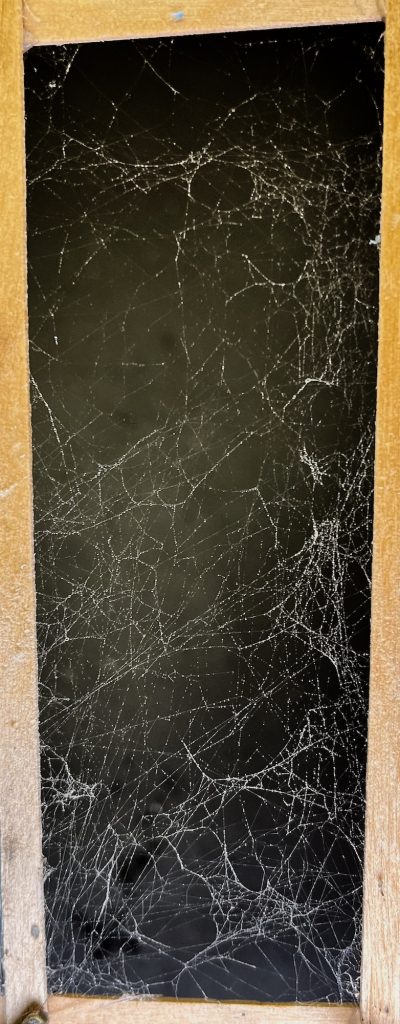I have realized that the way I raise spiders, in a plastic container with a 2-dimensional wooden frame assembled from coffee stirrers and hot glue, means that the spiders build cobwebs constrained to only 2 dimensions. Now I’m thinking it would be easier to study the rules they use to make these networks. Hmm…another student project?
This photo was shot with my iPhone. I think I could get something better with my Canon R and a lens opened wide, to f/1.4 or thereabouts, and a dark background set way back and out of focus. I may have to do some photography experiments.



Use a 180 macro fixed length lens, possibly setting on hyperlocal distance to get the 3-D aspect of the web.
Some side lighting and a fine spray mister wouldn’t hurt either. Or dust. But if you make a mistake, you can get rid of the water with some patience; the dust is there until the spiders take it down & rebuild.
The macro will blur out the background by virtue of physics. Using flash side lighting will darken the background. Use a smaller aperture, not a shallow one like f4.
If you use a regular lens, not a macro, all the webs will more or less blur together. Using a macro with a large depth of field achieved with small aperture should allow you to see the 3-D aspects without a distracting background. Side flash will just darken the background further.
*Hyperfocal distance. Stupid autocorrect.
That’s close to how I got this one: spraying a fine mist on the web, then side lighting with an LED panel.
The 3D aspects are negligible. They really do make sheet webs under these conditions, and looking at it from the side, there’s less than a millimeter of depth.
The less than the millimeter depth is why it’s handy to have the 180 macro. You will get separation, which might be handy in determining the spider rules for web building.
what’s the difference between a cobweb and a generic web?
@5 Dust ;)
@5. hillaryrettig1 : If memory serves – & could be mistaken – isn’t “cob” an old english word for spider? So a cob web then would be a web made by a spider as opposed to other creatures. I know a few other invertebrates eg. silkworms, some molluscs I gather, also produce silk and we have a mite whose exact name I’ve now forgotten in the local Belair National park that creates webs on plants – notably Gorse (Ulex europaeus) and Broom (Genista monspessulana & Cytisus scoparius) – that is used as a biocontrol on those invasive woody weeds.
I don’t know if there’s a specific word for webs by mites or silkworms – coccoons – or other web-making critters. Of course humans too make different webs of sorts – indeed I’m on one now..
.***
That picture and I guess the webs in general reminds me of the very largest structures in our cosmos cosmic filaments of clusters and superclusters of galaxies. Wonder what wove that and what it might be catching?
(Boring answer : gravity and more clusters and superclusters of galaxies. Including ours.)